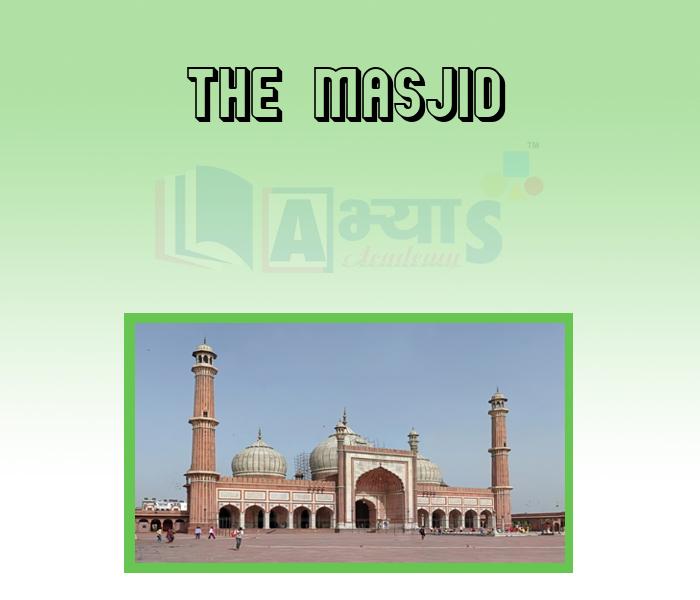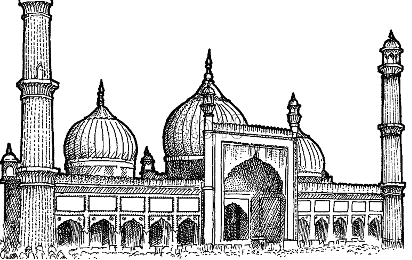The Masjid

The Masjid
The Masjid: A mosque is called a Masjid in Arabic, literally a place where a Muslim prostrates in reverence to Allah. During prayer, Muslims stand facing Mecca. In India this is to the west. This is called the qibla. The Delhi sultans built several mosques in cities all over the subcontinent. These demonstrated their claims to be protectors of Islam and Muslims. Mosques also helped to create the sense of a community of believers who shared a belief system and a code of conduct. It was necessary to reinforce this idea of a community because Muslims came from a variety of backgrounds.
:
The coming of Muslim rulers to India saw the birth of a new style of art and architecture that came to be known as the Indo-Islamic style. Indo -Islamic architecture was a blend of the local Indian style with the Islamic style. Since Islamic art itself was a composite of various influences -Turkish,Afghan,Persian and Arabi -Indo Islamic architecture showcased a wide variety of styles .In Delhi Islamic influences dominated , while in the Deccan ,local styles were more prominent in the buildings.In Bengal , the local rulers practice of using bricks for building continued .Indo -Islamic architecture was also influenced by the fact that the Muslim rulers often had to use Indian craftsmen, who were trained in the local styles.Building were simple ,with symmetrical and beautiful lines. They now featured Islamic elements such as arches and domes. Islam discourages the depiction of human figures in art.
Some of the earliest buildings built by the Muslims in India were their place of worship,or mosques. These shapes were new to India .A mosque has a sihn, an open rectangular courtyard at the center ,surrounded by Liwan, a pillared cloister with several entrances.A domed prayer ball stands at the western end of courtyard . At the back of the prayer hall stands at western end of the courtyard. At the back of the prayer hall is the mihrab (a niche) which indicates the direction of mecca , for the faithful to face while praying. To the right of the mihrab is the mimbar (pulpit) for the iman to conduct prayers. There is also the minar , a high slender tower, from where the Mu'zzain (priest) ca;lls the faithful to prayer.
Students / Parents Reviews [10]
My experience with Abhyas academy is very good. I did not think that my every subject coming here will be so strong. The main thing is that the online tests had made me learn here more things.

Hiya Gupta
8thMy experience with Abhyas is very good. I have learnt many things here like vedic maths and reasoning also. Teachers here first take our doubts and then there are assignments to verify our weak points.

Shivam Rana
7thAbout Abhyas metholodology the teachers are very nice and hardworking toward students.The Centre Head Mrs Anu Sethi is also a brilliant teacher.Abhyas has taught me how to overcome problems and has always taken my doubts and suppoeted me.

Shreya Shrivastava
8thOne of the best institutes to develope a child interest in studies.Provides SST and English knowledge also unlike other institutes. Teachers are co operative and friendly online tests andPPT develope practical knowledge also.

Aman Kumar Shrivastava
10thBeing a parent, I saw my daughter improvement in her studies by seeing a good result in all day to day compititive exam TMO, NSO, IEO etc and as well as studies. I have got a fruitful result from my daughter.

Prisha Gupta
8thIt has a great methodology. Students here can get analysis to their test quickly.We can learn easily through PPTs and the testing methods are good. We know that where we have to practice

Barkha Arora
10thIt was good as the experience because as we had come here we had been improved in a such envirnment created here.Extra is taught which is beneficial for future.

Eshan Arora
8thAbhyas Methodology is very good. It is based on according to student and each child manages accordingly to its properly. Methodology has improved the abilities of students to shine them in future.

Manish Kumar
10thIt was a good experience with Abhyas Academy. I even faced problems in starting but slowly and steadily overcomed. Especially reasoning classes helped me a lot.

Cheshta
10thMy experience was very good with Abhyas academy. I am studying here from 6th class and I am satisfied by its results in my life. I improved a lot here ahead of school syllabus.











